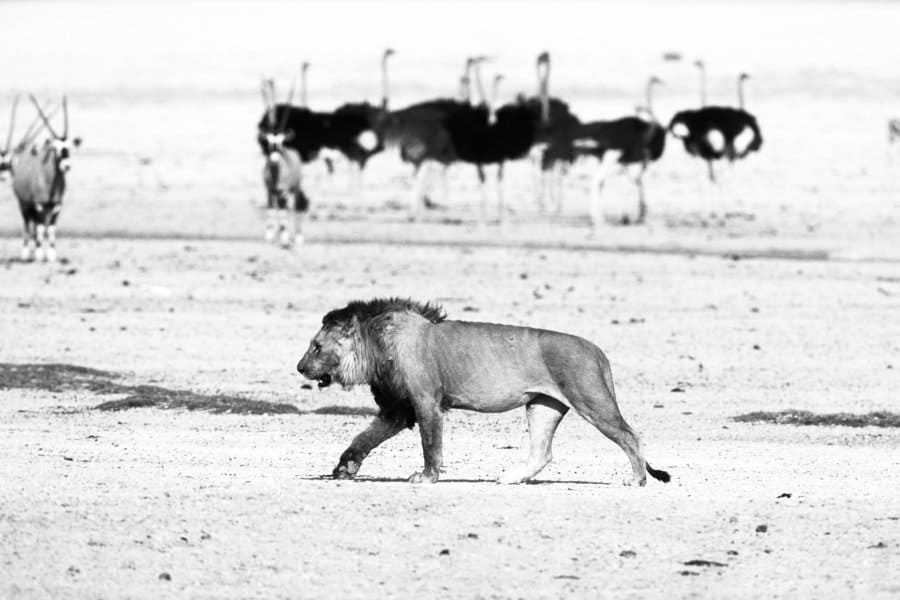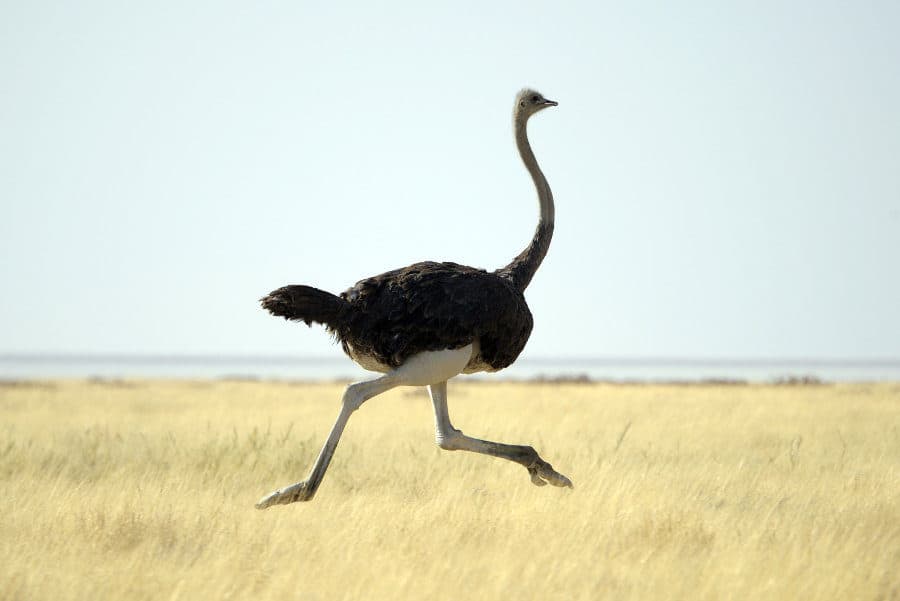Common ostriches are a large and unique species of bird, native to the African continent. They’re a familiar sight for most people around the world, yet few realize how interesting these flightless fellows really are.
Did you know that an ostrich has three stomachs? Or that they eat pebbles and have the ability to kill a lion?
These enormous birds hold plenty of fascinating trivia behind their feathery exteriors. And this post aims to bring these facts into the light, from the basics to the truly bizarre.
So read on to discover what makes the common ostrich a one of a kind African animal.
Ostrich Size – The World’s Largest Birds
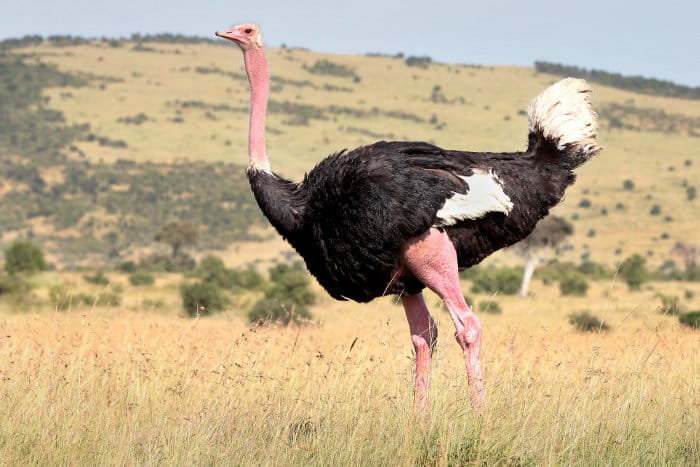
It’s common knowledge that ostriches are big birds. However, not many people know the extent of their size. Indeed, they are enormous; they’re larger than any other living bird species. And most of them are significantly bigger than the average human.
So, how big is an ostrich, exactly?
Ostrich weight
Ostriches, whose scientific name is Struthio camelus, can weigh anywhere between 100 kg and 160 kg. To put that into perspective, a large male ostrich will weigh around twice as much as the average human male.
The females, known as hens, are generally a little smaller than the males. Although they still tend to weigh over 100 kg.
Ostrich height
Ostriches can reach a staggering height of around 2.74 meters. That’s a full meter taller than the typical human male and over half a meter taller than the average door frame.
The tallest human ever to walk the Earth was a man by the name of Robert Wadlow. He stood at an incredible 2.7 meters tall – just shorter than a lanky ostrich.
Ostrich Habitat – Where Do Ostriches Live?
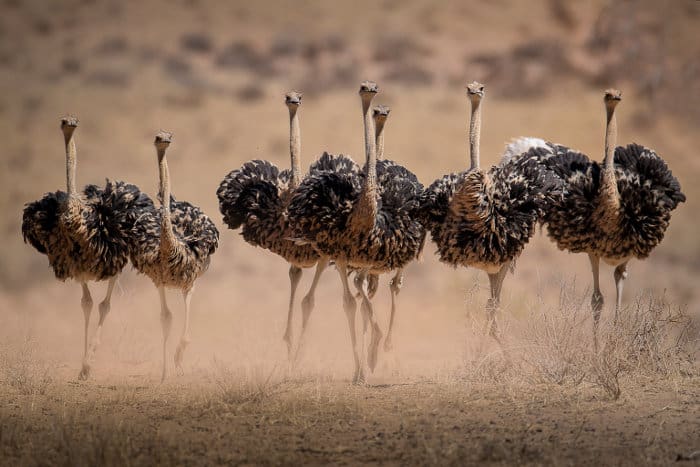
Ostriches are native to Africa, with most of them living in the southern and eastern parts of the continent. Although, some do reside in the more westerly and northern regions as well.
Their typical habitat is semiarid with low rainfall, and is mostly flat. So you will usually find them in Africa’s savannas, woodlands, grasslands, and plains.
Ostriches are primarily vegetarian by nature. However, they are not herbivores. They’re omnivores, finding nourishment by eating both plants and small animals that they find in the environment around them.
Ostriches Have Three Stomachs
Living in often harsh environments, ostriches eat a lot of tough plant matter. They use their three stomachs to metabolize these tough food sources, which they couldn’t otherwise digest.
Seeing as ostriches don’t have any teeth, they need some other way of breaking down the larger bits of food that they eat. They do so by eating pebbles and storing these small rocks in one of their specialized stomachs, called the ventriculus. Here, the food gets broken down before it moves onward to the small intestine.
Who would have thought?
Ostriches Can’t Fly
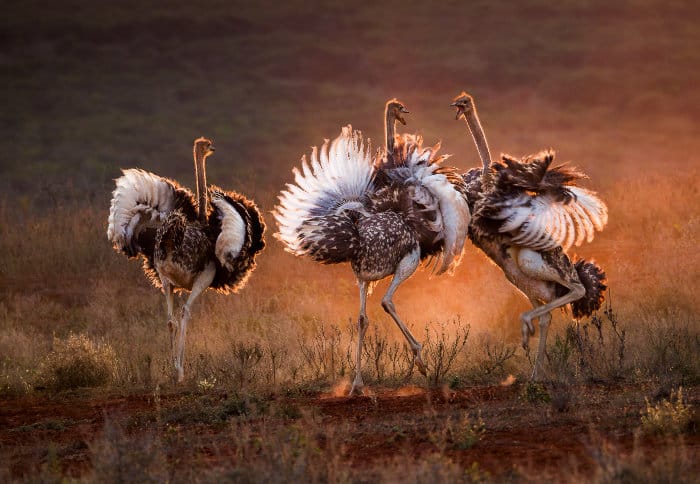
While ostriches are the largest birds, the title of ‘heaviest flying bird’ goes to a fellow African animal, the kori bustard.
Unlike most bird species, ostriches don’t possess the gift of flight. Their large, heavy bodies and less-than-optimal biology make them about as land-bound as an elephant.
However, that’s not to say that they don’t have any wings. In fact, ostriches boast an impressive wingspan of around 2 meters. And ostrich wings are useful, too.
Ostriches are excellent runners. And when they’re sprinting at impressive speeds, they use their wings to help keep them stable and to assist with making nimble turns. They also use their wings to shelter their chicks (baby ostriches) and shade their pale upper legs.
They even use their wings to conserve body heat and as part of a mating dance routine that the males perform to attract females.
Bonus fact: Skeptics of the theory of evolution have posed the question: What use is half a wing? They argue that wings couldn’t have developed through the process of evolution, because they would have to evolve first as useless appendages before becoming a flying tool.
Ostriches, however, show that having a non-flying, feathered limb is useful in its own right. And this type of limb could have evolved into functional wings in other species.
So ostriches may not be able to fly, but they can settle scientific debate.
They’re Incredibly Fast on Their Feet

Ostriches make up for their lack of flight with an impressive aptitude for running. At a sprint, the average ostrich can clock speeds of up to 70 km/h, making them one of the fastest animals in Africa.
The quickest ostriches ever recorded have hit speeds of around 100 km/h at their peak. That’s more than three times as fast as Usain Bolt.
Their powerful ostrich legs propel them swiftly across the African terrain, allowing them to cover up to 5 meters in a single stride.
This speed acts as a defense against predators; they’re able to outrun all but the speediest of killers.
Ostrich feet
Most bird species have three or four toes on each of their feet. This is another way in which ostriches set themselves apart; they are the only birds that have two toes on each foot.
Scientists believe that the unique toe arrangement on an ostrich foot helps the animals achieve their impressive running speeds.
Ostrich Egg Size – More Than the Average Omelette

It should come as little surprise that the world’s largest bird lays the world’s largest egg.
Ostrich eggs are around 23 times the size of chicken eggs, weighing in at up to 1.5 kg. They measure about 15 cm in length, with 3 mm-thick shells.
Female ostriches lay these enormous eggs in ‘dump nests’, which are a type of communal nest, shared by the herd (yes, a group of ostriches is called a herd, or flock).
Both males and females take turns sitting on the eggs as they incubate. This takes around 42 days, after which, a baby ostrich hatches from the egg.
Baby Ostriches
Just after hatching, an ostrich chick can be around the size of a small chicken – the largest newborn bird in the world. After a few days, they leave the safety of the nest and set off with their parents into open terrain.
Once again, the male and female ostriches work together to raise and protect the chicks from predators at this stage of their development.
Ostrich Predators
Endemic to the wide-open plains of Africa, ostriches have a range of formidable predators to be wary of. These include lions, cheetahs, hyenas, leopards, and hunting dogs. Occasionally, a crocodile might take a snap at an ostrich, too.
Young ostriches are most vulnerable to predators, as they’re slower, smaller, and more defenseless than their parents. However, the older ostriches aim to defend the chicks. Usually, a male lures predators away from the herd as the young flee with the females.
An Ostrich Kick is a Force to Be Reckoned With
While ostriches tend to run from predators as their first line of defense, they, fortunately, have another trick up their feathery sleeves; they can kick with lethal force.
A single blow from an ostrich’s powerful leg can be enough to kill even a lion. They also have sharp 10 cm-long claws on their feet, reinforcing their weapon-like status.
Ostriches Have Incredibly Large Eyes

At around the size of a billiard ball, an ostrich’s eye is larger than that of any other land animal. So big, in fact, that an ostrich’s eyeball is bigger than its brain! This gives them incredible eyesight (though perhaps not the highest IQ), which they use to spot predators from afar.
They Work With Grazers
Ostriches have cultivated a unique relationship with the animals that graze on the African savannas. They help one another by making use of their various skill sets.
The grazers stir up the dirt as they feed on grass, which in turn, helps bring bugs and little creatures to the surface. This allows the ostriches to eat the insects and small critters, which are of no value to the herbivorous grazers.
In return, the ostriches use their height and keen eyesight to alert the grazers of any predators looming in the distance.
What Sound Does an Ostrich Make?

Ostriches aren’t confined to just one kind of sound. Rather, they have a diverse palette of noises to choose from. You might hear them making whistling noises, growling, hooting, or hissing.
Males also sometimes make a low, booming noise, that sounds somewhat like a lion’s roar.
A Feathered, Flightless Farewell
Ostriches are record-breakers by nature. From their unmatched size and staggering speed, to their enormous eyeballs and killer karate kicks, there is more to these African birds than one might assume.
They’re bizarre creatures that seem more aligned with fantasy and the creatures of a distant past than with our modern world. Yet they’re very much alive (and kicking), and you can still see them with your own two eyes.
So next time you hear mention of an ostrich, be sure to jump in and enlighten your friends and family. And if you’d like to catch a glimpse of them in the wild, consider booking a tailor-made African safari, and embarking on the journey of a lifetime.

